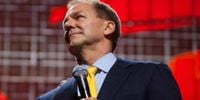The financial markets are grappling with a grim outlook as billionaire hedge-fund manager Paul Tudor Jones warns of new stock market lows, driven by President Donald Trump’s aggressive trade policies and the Federal Reserve’s steadfast monetary stance. Speaking on CNBC’s “Squawk Box,” Jones highlighted the detrimental combination of Trump’s unwavering commitment to tariffs and the Fed’s refusal to cut rates, stating, "You have Trump who’s locked in on tariffs. You have the Fed who’s locked in on not cutting rates. That’s not good for the stock market."
Trump’s imposition of 145% tariffs on Chinese imports this year, met with China’s retaliatory 125% levies, has already sparked significant volatility, with the S&P 500 (^GSPC) enduring a sharp sell-off before recovering to a level 8% below its all-time high. Jones, the founder of Tudor Investment and a legendary investor who famously profited from the 1987 market crash, remains skeptical of a near-term recovery, even if Trump reduces tariffs to 50% or 40%, describing such a move as equivalent to the largest tax increases since the 1960s, potentially shaving 2% to 3% off economic growth.
The Federal Reserve’s decision to maintain its key overnight lending rate between 4.25% and 4.5% since December further complicates the economic picture. Fed Chair Jerome Powell has emphasized a cautious approach, indicating that policymakers will "wait for greater clarity" on the fallout from trade policies before making adjustments. Jones believes this rigidity, absent a significant shift to a dovish stance with substantial rate cuts, will push stocks to new lows. He suggests that only after reaching these depths might market pressures force both the Fed and Trump to recalibrate their approaches, potentially stabilizing conditions.
The prospect of China initiating trade negotiations with the U.S., as signaled last week, offers a glimmer of hope, but Jones remains unconvinced that near-term relief is forthcoming. His perspective is informed by decades of market experience and his current role as chairman of Just Capital, a nonprofit focused on evaluating U.S. companies’ social and environmental performance. As macroeconomic headwinds intensify, Jones’ prognosis underscores the challenges facing investors navigating a landscape marked by trade tensions and monetary policy constraints.
Jones expects that even if President Trump reduces China tariffs by 50%, the stock market could still reach new lows. He communicated his views during a CNBC interview on May 6, 2025. Jones referred to the levies as "the largest tax increase since the ’60s" and warned that without a rate cut from the U.S. Federal Reserve, the stock market is likely to hit new lows. He suggested that if the stock market falls significantly, it would likely prompt action from both the Fed and Trump.
Furthermore, Jones believes that the market is under too much pressure from tariffs and interest rates. He noted that the S&P 500 has clawed back most of its losses since the historic April sell-off but remains vulnerable. Stocks moving back to another low would imply the benchmark index falling to at least 4,982, a 10% decline from current levels. He added that markets are expecting Trump to dial back his tariffs on China significantly, estimating that investors are pricing in a tariff rate of about 50%.
Interestingly, Jones pointed out that even if tariffs were to be slashed to that level, the impact of the duties would still be equivalent to the largest tax hike imposed on U.S. consumers since the 1960s, which could potentially shave off around 2 to 3 percentage points of U.S. GDP. The Fed, meanwhile, insists on proceeding cautiously with rate cuts. According to the CME FedWatch tool, markets are pricing in a near-100% chance the central bank will leave rates unchanged at this week’s policy meeting.
Wells Fargo has indicated it wouldn't be surprised if the S&P 500 retested its lows from the initial tariffs-fueled sell-off, due to lingering economic pressures from trade policy. Scott Wren, a senior global market strategist at the bank, wrote in a note last week, "We keep getting the absolutely rational question: 'Have we seen the bottom in stocks?' As much as we would like to boldly answer that question with a resounding 'yes!' that just isn't the case. Again, tariff and growth concerns are the main market drivers right now, but there will likely be a few other issues that result in road bumps in the months ahead."
HSBC also expressed a "tactically cautious" stance on risk assets, suggesting that while there have been upside surprises in hard data lately, these have largely been due to frontloading. Forward-looking indications are for hard data to feel the pain soon, perhaps already in the next month or two, according to a note from the bank.
In conclusion, the outlook for the stock market remains precarious as investors weigh the implications of Trump's tariffs and the Fed's interest rate policy. Jones' insights serve as a sobering reminder of the volatility that can arise from geopolitical and economic tensions, urging caution among market participants as they navigate this uncertain landscape.

